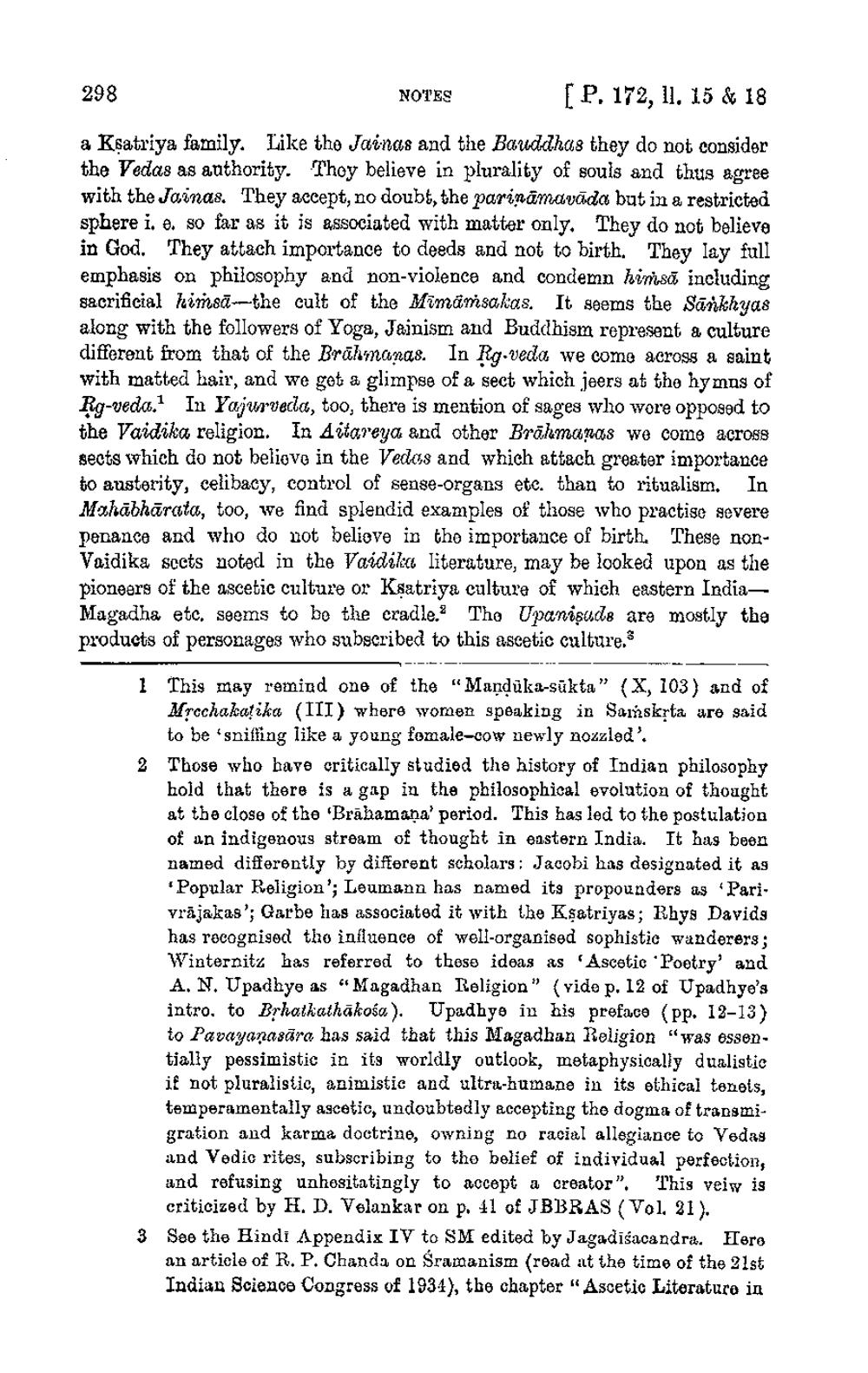________________
298
NOTES
[P, 172, 11. 15 & 18
a Ksatriya family. Like the Jainas and the Bauddhas they do not consider the Vedas as authority. Thoy believe in plurality of souls and thus agree with the Joinas. They accept, no doubt, the parināmavāda but in a restricted sphere i. e. so far as it is associated with matter only. They do not believe in God. They attach importance to deeds and not to birth. They lay full emphasis on philosophy and non-violence and condemn hinsă including sacrificial himsa--the cult of the Mināmsakas. It seems the sankhyas along with the followers of Yoga, Jainism and Buddhism represent a culture different from that of the Brāhmanas. In Rg.veda we come across a saint with matted hair, and we got a glimpse of a sect which jeers at the hymns of Rg-veda. In Yajurveca, too, there is mention of sages who wore opposed to the Vaidika religion. In Aitareya and other Brālumanas we come across sects which do not beliove in the Vedos and which attach greater importance to austerity, celibacy, control of sense-organs etc. than to ritualism. In Mahābhārata, too, we find splendid examples of those who practise severe penance and who do not beliove in the importance of birth. These nonVaidika sccts noted in the Vaidilece literature, may be looked upon as the pioneers of the ascetic culture or Ksatriya culture of which eastern India, Magadha etc. seems to be the cradle. The Upanişuds are mostly the products of personages who subscribed to this ascetic culture.
1 This may remind one of the "Manduka-sūkta" (X, 103) and of
Myochakaļika (III) where women speaking in Sanskrta are said
to be 'sniffing like a young fomale-cow newly nozzled'. 2 Those who have critically studied the history of Indian philosophy
hold that there is a gap in the philosophical evolution of thought at the close of the 'Brāhamana' period. This has led to the postulation of an indigenous stream of thought in eastern India. It has been named differently by different scholars : Jacobi has designated it ag
Popular Religion'; Leumann has named its propounders as Parivrājakas'; Garbe has associated it with the Ksatriyas; Rhys Davids has recognised the influence of well-organised sophistic wanderers ; Winternitz has referred to these ideas as Ascetic Poetry and A. N. Upadhye as “Magadhar Religion” (vide p. 12 of Upadhye's intro, to Brhatkathākośa). Upadhye in his preface (pp. 12-13) to Pavayanasāra has said that this Magadhan Religion "was essentially pessimistic in its worldly outlook, metaphysically dualistic if not pluralistic, animistic and ultra-humano in its ethical teneis, temperamentally ascetic, undoubtedly accepting the dogma of transmigration and karma doctrine, owning no racial allegiance to Vedas and Vedic rites, subscribing to the belief of individual perfection, and refusing unhesitatingly to accept a creator". This veiw is
criticized by H. D. Velankar on p. 41 of JBBRAS (Vol. 21). 3 See the Hindi Appendix IV to SM edited by Jagadisacandra. Here
an article of R. P. Chanda on Šramanism (read at the time of the 21st Indian Science Congress of 1934), the chapter "Ascetic Literaturo in




